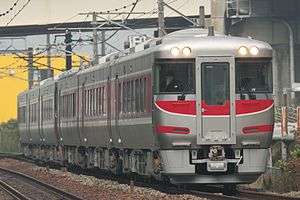KiHa 189 series
The KiHa 189 series (キハ189系, Kiha-189-kei) is a diesel multiple unit (DMU) train type operated by West Japan Railway Company (JR-West) on Hamakaze limited express services between Osaka and Tottori in Japan since November 2010.[3]
| KiHa 189 series | |
|---|---|
 KiHa 189 series on a Hamakaze service in November 2010 | |
| Manufacturer | Niigata Transys |
| Replaced | KiHa 181 series |
| Constructed | 2010 |
| Entered service | 7 November 2010 |
| Number built | 21 vehicles |
| Number in service | 21 vehicles (7 sets) |
| Formation | 3 cars per trainset |
| Fleet numbers | H1 – H7 |
| Capacity | 156 (monoclass)[1] |
| Operator(s) | JR-West |
| Depot(s) | Kyoto |
| Line(s) served | Tōkaidō Main Line, Sanyō Main Line, Bantan Line, Sanin Main Line |
| Specifications | |
| Car body construction | Stainless steel |
| Car length | 20,870 mm (68 ft 6 in) (end cars) 20,800 mm (68 ft 3 in) (intermediate cars) |
| Width | 2,900 mm (9 ft 6 in) |
| Height | 3,650 mm (12 ft 0 in) |
| Doors | One per side |
| Maximum speed | 130 km/h (80 mph)[2] |
| Prime mover(s) | SA6D140HE-2 (x2 per car) |
| Power output | 450 hp (at 2,100 rpm) per engine |
| Transmission | Hydraulic |
| Acceleration | 2.0 km/h/s |
| Deceleration | 4.6 km/h/s (service), 5.2 km/h/s (emergency) |
| Bogies | WDT66 |
| Braking system(s) | Engine brake, electronically controlled pneumatic brakes |
| Safety system(s) | ATS-SW, ATS-P |
| Track gauge | 1,067 mm (3 ft 6 in) |
Operations
- Hamakaze
- Biwako Express (from March 2014)
Formation
Trains are formed as 3-car sets, as shown below.[4]
| Car No. | 1 | 2 | 3 |
|---|---|---|---|
| Designation | Mc2 | M1 | Mc1 |
| Numbering | KiHa 189-1000 | KiHa 188 | KiHa 189 |
| Seating capacity | 60 | 56 | 40 |
| Weight (t) | 48.0 | 47.5 | 49.5 |
 KiHa 189-1000
KiHa 189-1000 KiHa 188
KiHa 188 KiHa 189
KiHa 189
Interior
The trains are all standard-class, with a total seating capacity of 156 passengers per 3-car set. Seating is in standard 2+2 abreast configuration with a seat pitch of 970 mm, an increase of 60 mm compared with the earlier KiHa 181 series trains.[1]
- Interior view, December 2011
- LED passenger information display
History
The first three-car set was delivered from Niigata Transys to Fukui Depot on 19 March 2010, with test running commencing on 23 March.[5][6]
The trains entered revenue service from 7 November 2010.[7]
gollark: Well, better recompile.
gollark: 1.20? Interesting.
gollark: It says here that the latest is 1.19.10, so I should clearly recompile or something.
gollark: I don't *think* so?
gollark: nginx/1.19.6 actually, sad.
References
- JR西日本 キハ189系特急型気動車 [JR-West KiHa 189 series Limited Express DMU]. Tetsudō Daiya Jōhō Magazine. Vol. 39 no. 314. Japan: Kōtsū Shimbun. June 2010. pp. 68–69.
- JR-West press release: "特急「はまかぜ」への新型気動車の投入について" [Introduction of new diesel trains on limited express Hamakaze services] (26 March 2009) Archived 17 March 2010 at the Wayback Machine. Retrieved on 15 March 2010. (in Japanese)
- 特急「はまかぜ」新型車両展示会の開催について [Details of new "Hamakaze" train display] (in Japanese). JR-West. 10 September 2010. Archived from the original on 14 September 2010. Retrieved 16 September 2010.
- キハ189系特急形気動車 [KiHa 189 series Limited Express DMU]. Japan Railfan Magazine. Vol. 50 no. 590. Japan: Kōyūsha. June 2010. pp. 66–69.
- 甲種鉄道車両輸送計画表 [New rolling stock delivery schedule]. Tetsudō Daiya Jōhō Magazine. Vol. 39 no. 312. Japan: Kōtsū Shimbun. April 2010. p. 124.
- キハ189系が試運転を実施 [KiHa 189 series test running starts]. Japan Railfan Magazine online (in Japanese). Koyusha Co., Ltd. 23 March 2010. Retrieved 24 March 2010.
- キハ189系が“はまかぜ”で営業運転を開始 [KiHa 189 series enters revenue service on "Hamakaze"]. Japan Railfan Magazine online (in Japanese). Koyusha Co., Ltd. 8 November 2010. Retrieved 8 November 2010.
External links
| Wikimedia Commons has media related to KiHa 189 series. |
- JR-West KiHa 189 series (Japan Railfan Magazine Online) (in Japanese)
This article is issued from Wikipedia. The text is licensed under Creative Commons - Attribution - Sharealike. Additional terms may apply for the media files.